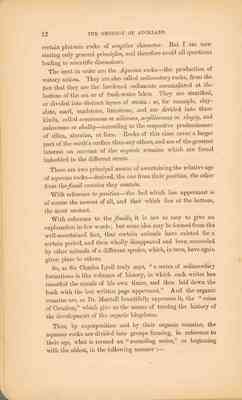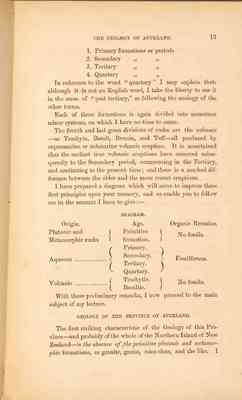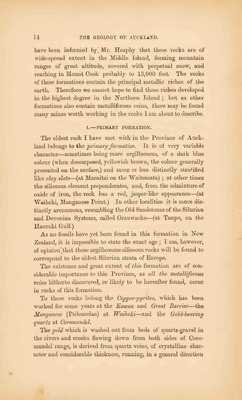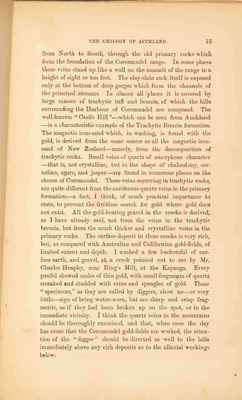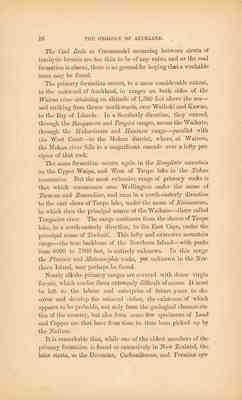Pages
12 THE GEOLOGY OF AUCKLAND
certain plutonic rocks of eruptive character. But I am now stating only general principles, and therefore avoid all questions leading to scientific discussions.
The next in order are the Aqueous rocks - the production of watery action. They are so called sedimentary rocks, from the fact that they are the hardened sediments accumulated at the bottom of the sea or of fresh-water lakes. They are stratified or divided into distinct layers of strata : as, for example, clayslate, marl, sandstone, limestone, and are divided into three kinds, called arenaceous or siliceous, argillaceous or clayey, and calcareous or chalky - according to the respective predominance of silica, alumina, or lime. Rocks of this class cover a larger part of the earth's surface than any others, and are of the greatest interest on account of the organic remains which are found imbedded in the different strata.
There are two principal means of ascertaining the relative age of aqueous rocks - derived, the one from their position, the other from the fossil remains they contain.
With reference to position - the bed which lies uppermost is of course the newest of all, and that which lies at the bottom, the most ancient.
With reference to the fossils, it is not so easy to give an explanation in few words; but some idea may be formed from the well-ascertained fact, that certain animals have existed for a certain period, and then wholly disappeared and been succeeded by other animals of a different species, which, in turn, have again given place to others.
So, as Sir Charles Lyell truly says, "a series of sedimentary formations is like volumes of history, in which each writer has recorded the annals of his own times, and then laid down the book with the last written page uppermost." And the organic remains are, as Dr. Mantell beautifully expresses it, the "coins of Creation," which give us the means of tracing the history of the development of the organic kingdoms.
Thus, by superposition and by their organic remains, the aqueous rocks are divided into groups forming, in reference to their age, what is termed an "ascending series," or beginning with the oldest, in the following manner:-
THE GEOLOGY OF AUCKLAND 13
1. Primary formation or periods 2. Secondary " " 3. Tertiary " " 4. Quartarty " "
In reference to the word "quartary" I may explain that, although it is not an English word, I take the liberty to use it in the sense of "post tertiary," as following the analogy of the other terms.
Each of those formations is again divided into numerous minor systems, on which I have no time to enter.
The fourth and last great divisions of rocks are the volcanic - as Trachyte, Basalt, Breccia, and Tuff - all produced by supramarine or submarine volcanic eruption. It is ascertained that the earliest true volcanic eruptions have occurred subsequently to the Secondary period, commencing in the Tertiary, and continuing to the present time; and there is a marked difference between the older and the more recent eruptions.
I have prepared a diagram which will serve to impress these first principles upon your memory, and so enable you to follow me in the account I have to give:-
DIAGRAM Origin. Age. Organic Remains. Plutonic and { Primitive. } Metamorphic rocks { formation. } No fossils.
{ Primary. } { Secondary. } Fossilferous. Aqueous ............... { Tertiary. } { Quartary. }
{ Trachytic. } Volcanic................ { Basaltic. } No fossils.
With these prelinary remarks, I now proceed to the main subject of my lecture.
GEOLOGY OF THE PROVINCE OF AUCKLAND. The first striking characteristic of th Geology of this Province - and probably of the whole of the Northern Island of New Zealand - is the absence of the primitive plutonic and metamorphic formations, as granite, gneiss, mica-slate, and the like. I
14. THE GEOLOGY OF AUCKLAND
have been informed by Mr Heaphy that these rocks are of wide-spread extent in the Middle Island, forming mountain ranges of great altitude, covered with perpetual snow, and reaching in Mount Cook probably to 13,000 feet. The rocks of these formations contain the principal metallic riches of the earth. Therefore we cannot hope to find these riches developed in the highest degree in the Northern Island; but as other formations also contain metalliferous veins, there may be found many mines worth working in the rocks I am about to describe.
I. - PRIMARY FORMATIONS. The oldest rock I have met with in the Province of Auckland belongs to the primary formation. It is of very variable character - sometimes being more argillaceous, of a dark blue colour (when decomposed, yellowish brown, the colour generally presented on the surface,) and more or less distinctly stratified like clay slate - (at Maraitai on the Waitemata); at other times the siliceous element preponderates, and, from the admixture of oxide of iron, the rock has a red, jasper-like appearance - (at Waiheki, Manganese Point.) In other localities it is more distinctly arenaceous, resembling the Old Sandstones of the Silurian and Devonian Systems, called Grauwacke - (at Taupo, on the Hauraki Gulf.)
As no fossils have yet been found in this formation in New Zealand, it is impossible to state the exact age; I am, however, of opinion that these argillaceous siliceous rocks will be found to correspond to the oldest Silurian strata of Europe.
The existence and great extent of this formation are of considerable importance to this Province, as all the metalliferous veins hitherto discovered, or likely to be hereafter found, occur in rocks of this formation.
To these rocks belong the Copper-pyrites, which has been worked for some years at the Kawau and Great Barrier - the Manganese (Psilomelan) at Waiheki - and the Gold-bearing quartz at Coromandel.
The gold which is washed out from beds of quartz-gravel in the rivers and creeks flowing down from both sides of Coromandel range, is derived from quartz veins, of crystalline character and considerable thickness, running, in a general direction
THE GEOLOGY OF AUCKLAND 15
from North to South, through the old primary rocks which form the foundation of the Coromandel range. In some places these veins stand up like a wall on the summit of the range to a height of eight or ten feet. The clay-slate rock itself is exposed only at the bottom of deep gorges which form the channels of the principal streams. In almost all places it is covered by large masses of trachytic tuff and breccia, of which the hills surrounding the Harbour of Coromandel are composed. The well-known "Castle Hill" - which can be seen from Auckland - is a characteristic example of the Trachytic Breccia formation. The magnetic iron-sand which, in washing, is found with the gold, is derived from the same source as all the magnetic ironsand of New Zealand - namely, from the decomposition of trachytic rocks. Small veins of quartz of amorphous character - that is, not cystalline, but in the shape of chalcedony, cornelian, agate, and jasper - are found in numerous places on the shores of Coromandel. These veins occurring in trachytic rocks, are quite different from the auriferous quartz veins in the primary formation - a fact, I think, of much practical importance to state, to prevent the fruitless search for gold where gold does not exist. All the gold-bearing gravel in the creeks is derived, as I have already said, not from the veins in the trachytic breccia, but from the much thicker and crystalline veins in the primary rocks. The surface-deposit in those creeks is very rich, but, as compared with Australian and Californian gold-fields, of limited extent and depth. I washed a few bucketsful of surface earth, and gravel, at a creek pointed out to me by Mr. Charles Heaphy, near Ring's Mill, at the Kapanga. Every panful showed scales of thin gold, with small fragments of quartz streaked and studded with veins and spangles of gold. These "specimens," as they are called by diggers, show no - or very little - sign of being water-worn, but are sharp and crisp fragments, as if they had been broken up on the spot, or in the immediate vicinity. I think the quartz veins in the mountains should be thoroughly examined, and that, when once the day has come that the Coromandel gold-fields are worked, the attention of the "digger" should be directed as well to the hills immediately above any rich deposits as to the alluvial workings below.
16 THE GEOLOGY OF AUCKLAND.
The Coal Beds at Coromandel occurring between strata of trachytic breccia are too thin to be of any value, and as the coal formation is absent, there is no ground for hoping that a workable seam may be found.
The primary formation occurs, to a more considerable extent, to the eastward of Auckland, in ranges on both sides of the Wairoa river attaining an altitude of 1,500 feet above the sea - and striking from thence northwards, over Waiheki and Kawau, to the Bay of Islands. In a Southerly direction, they extend, through the Hangawera and Taupiri ranges, across the Waikato, through the Hakarimata and Hauturu range - parallel with the West Coast - to the Mokau district, where at Wairere, the Mokau river falls in a magnificent cascade over a lofty precipice of that rock.
The same formation occurs again in the Rangitoto mountain on the Upper Waipa, and West of Taupo lake in the Tuhua mountains. But the most extensive range of primary rocks is that which commences near Wellington under the name of Tararua and Ruawahine, and runs in a north-easterly direction to the east shore of Taupo lake, under the name of Kaimanawa, in which rises the principal source of the Waikato - there called Tongariro river. The range continues from the shores of Taupo lake, in a north-easterly direction, to the East Cape, under the principal name of Tewhaiti. This lofty and extensive mountain range - the true backbone of the Northern Island - with peaks from 6000 to 7000 feet, is entirely unknown. In this range the Plutonic and Metamorphic rocks, yet unknown in the Northern Island, may perhaps be found.
Nearly all the primary ranges are covered with dense virgin forests, which render them extremely difficult of access. It must be left to the labour and enterprise of future years to discover and develop the mineral riches, the existence of which appears to be probable, not only from the geological characteristics of the country, but also from some few specimens of Lead and Copper ore that have from time to time been picked up by the Natives.
It is remarkable that, while one of the oldest members of the primary formation is found so extensively in New Zealand, the later strata, as the Devonian, Carboniferous, and Permian sys-
